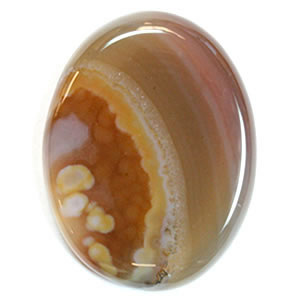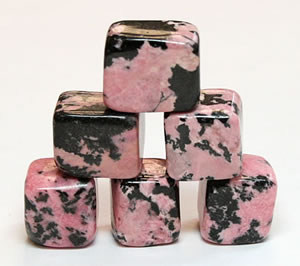Polishing Cabochons and Beads in a Rock Tumbler

A Brazilian agate cabochon that was sanded and polished in a vibratory rock tumbler. You can save ten to twenty minutes per cab by letting a tumbler do the fine sand and polish. The tumbler will also polish the back and nicely camber the edges. It will produce a very uniform polish if your objects are made from a material of consistent hardness.
Sanding and Polishing Cabochon Preforms
If you cut cabochons, beads or other small lapidary items, you might be able to save a lot of time by allowing a rock tumbler to do the final sanding and polishing steps.
A tumbler will produce a uniform, super-bright polish on almost any small, smooth object made from agate, jasper, quartz, petrified wood or other lapidary material with a Mohs hardness between about 5 and 7.
The Brazilian Agate cabochon pictured on this page was cut to shape using a rock saw and diamond wheel, then briefly sanded on an expanding drum to remove ridges left by the diamond wheel. It was then placed in a rock tumbler for final sanding and polishing.
The result is a cabochon with a fantastic polish, smoothly cambered edges and a nicely polished back. It would take a lot of hand labor and a lot of time to produce this type of finish.
The rhodonite cubes (pictured below) were cut on a rock saw, then sanded and polished in a rock tumbler. With very little labor you can sand and polish hundreds of 1/2" cubes simultaneously in a rock tumbler.
But, before you get excited, take a look at the shapes of the cubes. The tumbler had its way with them.
The Risks of Allowing the Tumbler to Take Over
There are risks to using the tumbler on objects that have a very uniform shape, details that are in positive relief, sharp points and edges, or variable composition. The tumbler is going to...
- abrade points and edges more severely than other parts of the piece
- abrade less durable spots more severley than other parts of the piece
- abrade features in positive relive most severely
- abrade protrusions more severely than other parts of the piece

These rhodonite cubes were cut on a rock saw, then sanded and polished in a rock tumbler. Imagine how long it would take to polish these by hand and round the points and edges! But, there was some sacrifice in the shape and proportions of the cubes. Can you tolerate that?
The Economics of Mass Finishing
Let's say that you have a couple hundred small rhodonite cubes (or beads or cabochons) that are up to about 1" in size or smaller. These are straight off of a rock saw or a grinding wheel with no additional sanding done. Your goal is to sand them smooth, gently round the points and edges, and achieve a very bright polish on all outward-facing smooth surfaces.
Here's how we would tumble them and how much it would cost...
1) Run them for two days in a single Lot-O-Tumbler with ceramic media and two ounces of medium silicon carbide grit. Rinse and add fresh grit about once a day.
2) Thoroughly rinse and run for two days in fine silicon carbide grit. Check a couple times per day and add water if needed.
3) Thoroughly rinse and run for two days in TXP aluminum oxide polish. Check a couple times per day and add water if needed.
4) Rinse, dry, separate cubes from ceramic cylinders and admire your great polish!
If you have a work area, materials and tumbler ready to do the above work, it could be done with about 2 hours of work, about $1.50 in electricity, and about $2.00 for grit and polish. Doing all of that work by hand would require a much greater investment of time and much higher cost of supplies. The savings are substantial. (For more information, see our article on the costs of rock tumbling.)
When it Doesn't Work
Mass finishing in a tumbler works great if all of the items you are polishing are smooth, simple shapes (such as cabochons or cubes) and are of uniform hardness - and you can tolerate some imperfection in the final shape of the finished pieces. Complex shapes do not polish well. Protrusions are shortened, surface textures are smoothed, tiny nooks and crannies are missed, and concave surfaces are lightly done if done at all. If the items that you are tumbling have zones of harder or softer material, they will sand and polish at different rates. Hard materials will stand up in positive relief. Soft materials will be worn away. It is best to experiment with a few unimportant pieces before you go into mass production with valuable items.
Which Tumbler?
For mass finishing, use a tumbler that is large enough to process your materials. Cushion your items with lots of ceramic cylinders. A vibratory tumbler smooths surfaces quickly, preserves the original shape of your items, and uses less grit. A rotary tumbler rounds protrusions, takes longer and uses more grit.
Our Choice
If we were going to tumble a lot of preforms, we would use a Lot-O-Tumbler or a Thumler's UV-10. These are both vibratory tumblers that will work fast, use very little grit and be relatively gentle on your items. The UV-10 will process pieces up to about 2 3/4" across, and the Lot-O-Tumbler takes pieces up to about 2". We recommend using lots of ceramic cylinders when tumbling fragile items. Use small cylinders if you have small objects or objects that have lots of fine detail. When processing new materials don't hesitate to spend time experimenting and planning - that's how you get the best results - and avoid disasters. Good luck!
Happy Tumbling!
RockTumbler.com Authors
 |
Hobart M. King has decades of rock tumbling experience and writes most of the articles on RockTumbler.com. He has a PhD in geology and is a GIA graduate gemologist. He also writes the articles about rocks, minerals and gems on Geology.com. |

